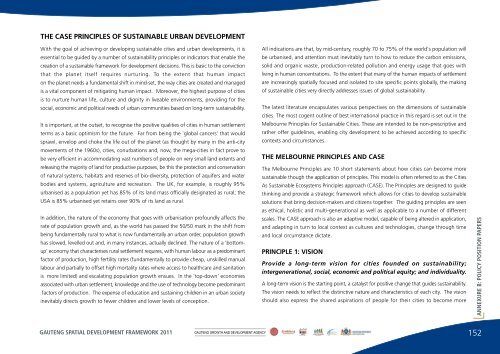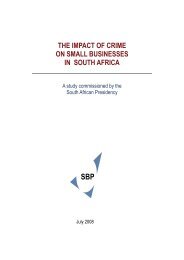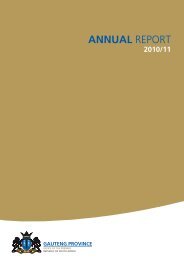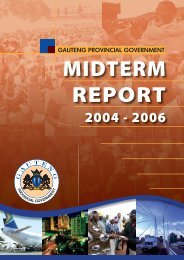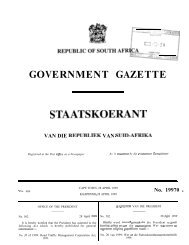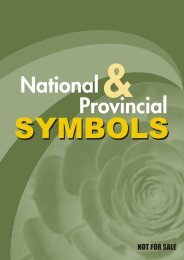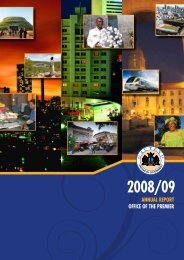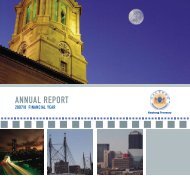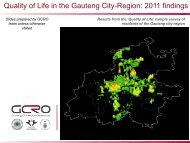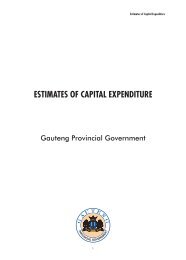the gauteng spatial development framework - Gauteng Online
the gauteng spatial development framework - Gauteng Online
the gauteng spatial development framework - Gauteng Online
Create successful ePaper yourself
Turn your PDF publications into a flip-book with our unique Google optimized e-Paper software.
THE CASE PRINCIPLES OF SUSTAINABLE URBAN DEVELOPMENTWith <strong>the</strong> goal of achieving or developing sustainable cities and urban <strong>development</strong>s, it isessential to be guided by a number of sustainability principles or indicators that enable <strong>the</strong>creation of a sustainable <strong>framework</strong> for <strong>development</strong> decisions. This is basic to <strong>the</strong> convictionthat <strong>the</strong> planet itself requires nurturing. To <strong>the</strong> extent that human impacton <strong>the</strong> planet needs a fundamental shift in mind-set, <strong>the</strong> way cities are created and managedis a vital component of mitigating human impact. Moreover, <strong>the</strong> highest purpose of citiesis to nurture human life, culture and dignity in liveable environments, providing for <strong>the</strong>social, economic and political needs of urban communities based on long-term sustainability.It is important, at <strong>the</strong> outset, to recognise <strong>the</strong> positive qualities of cities in human settlementterms as a basic optimism for <strong>the</strong> future. Far from being <strong>the</strong> 'global cancers' that wouldsprawl, envelop and choke <strong>the</strong> life out of <strong>the</strong> planet (as thought by many in <strong>the</strong> anti-citymovements of <strong>the</strong> 1960s), cities, conurbations and, now, <strong>the</strong> mega-cities in fact prove tobe very efficient in accommodating vast numbers of people on very small land extents andreleasing <strong>the</strong> majority of land for productive purposes, be this <strong>the</strong> protection and conservationof natural systems, habitats and reserves of bio-diversity, protection of aquifers and waterbodies and systems, agriculture and recreation. The UK, for example, is roughly 95%urbanised as a population yet has 85% of its land mass officially designated as rural; <strong>the</strong>USA is 85% urbanised yet retains over 90% of its land as rural.In addition, <strong>the</strong> nature of <strong>the</strong> economy that goes with urbanisation profoundly affects <strong>the</strong>rate of population growth and, as <strong>the</strong> world has passed <strong>the</strong> 50/50 mark in <strong>the</strong> shift frombeing fundamentally rural to what is now fundamentally an urban order, population growthhas slowed, levelled out and, in many instances, actually declined. The nature of a 'bottomup'economy that characterises rural settlement requires, with human labour as a predominantfactor of production, high fertility rates (fundamentally to provide cheap, unskilled manuallabour and partially to offset high mortality rates where access to healthcare and sanitationis more limited) and escalating population growth ensues. In <strong>the</strong> 'top-down' economiesassociated with urban settlement, knowledge and <strong>the</strong> use of technology become predominantfactors of production. The expense of education and sustaining children in an urban societyinevitably directs growth to fewer children and lower levels of conception.All indications are that, by mid-century, roughly 70 to 75% of <strong>the</strong> world's population willbe urbanised, and attention must inevitably turn to how to reduce <strong>the</strong> carbon emissions,solid and organic waste, production-related pollution and energy usage that goes withliving in human concentrations. To <strong>the</strong> extent that many of <strong>the</strong> human impacts of settlementare increasingly <strong>spatial</strong>ly focused and isolated to site specific points globally, <strong>the</strong> makingof sustainable cities very directly addresses issues of global sustainability.The latest literature encapsulates various perspectives on <strong>the</strong> dimensions of sustainablecities. The most cogent outline of best international practice in this regard is set out in <strong>the</strong>Melbourne Principles for Sustainable Cities. These are intended to be non-prescriptive andra<strong>the</strong>r offer guidelines, enabling city <strong>development</strong> to be achieved according to specificcontexts and circumstances.THE MELBOURNE PRINCIPLES AND CASEThe Melbourne Principles are 10 short statements about how cities can become moresustainable though <strong>the</strong> application of principles. This model is often referred to as <strong>the</strong> CitiesAs Sustainable Ecosystems Principles approach (CASE). The Principles are designed to guidethinking and provide a strategic <strong>framework</strong> which allows for cities to develop sustainablesolutions that bring decision-makers and citizens toge<strong>the</strong>r. The guiding principles are seenas ethical, holistic and multi-generational as well as applicable to a number of differentscales. The CASE approach is also an adaptive model, capable of being altered in application,and adapting in turn to local context as cultures and technologies, change through timeand local circumstance dictate.PRINCIPLE 1: VISIONProvide a long-term vision for cities founded on sustainability;intergenerational, social, economic and political equity; and individuality.A long-term vision is <strong>the</strong> starting point, a catalyst for positive change that guides sustainability.The vision needs to reflect <strong>the</strong> distinctive nature and characteristics of each city. The visionshould also express <strong>the</strong> shared aspirations of people for <strong>the</strong>ir cities to become moreANNEXURE B: POLICY POSITION PAPERSGAUTENG SPATIAL DEVELOPMENT FRAMEWORK 2011GAUTENG GROWTH AND DEVELOPMENT AGENCY152


